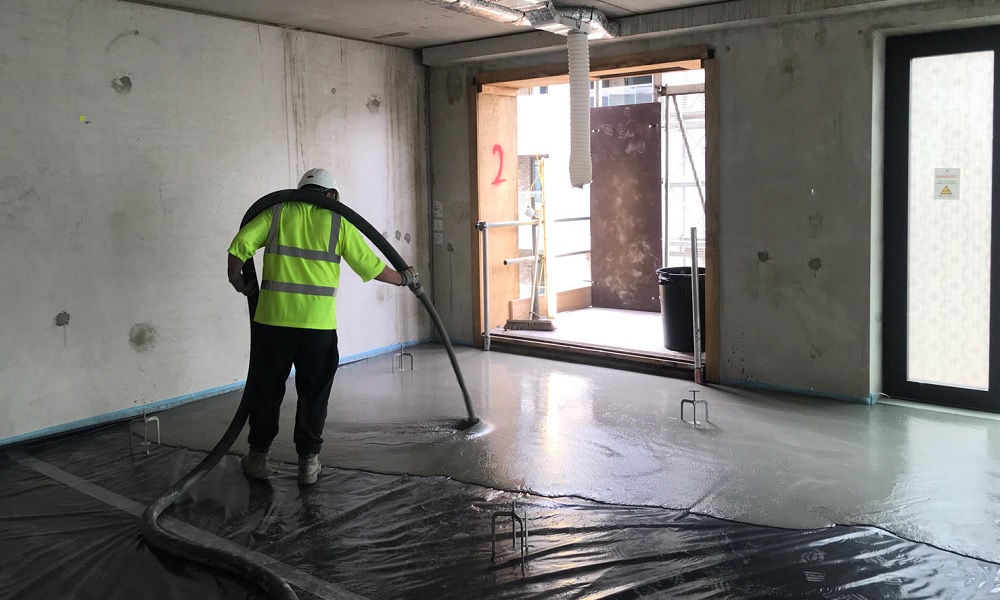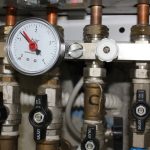Pumped Cementitious Screed – The new kid on the block
Cement Based Flowing Screeds – What are they and why are they gaining a growing share of the construction market?
This relatively new method of solving the age old issue of creating a level floor for final finishing has certainly gained a major foothold in the market and we wonder how long it will be before it starts to take significant market share from pumped calcium sulphate anhydrite screed as the product of choice for screeding professionals.
In many respects both flowing cement based screed and pumped anhydrite screed provide the same benefits over a traditional sand cement screed namely speed of installation and the ability to cover large areas quickly.
Flowing Screeds – Benefits
In a world where time is money flowing screeds allow much larger areas to be completed in the much less time that a traditional screed – often 800 to 1,000 square metres a day. Both can also be laid to much thinner depths, as little as 25mm – 30mm saving both the amount of product required and cost.
As both are self levelling screeds, both will give the required accuracy of level and surface regularity meaning there is no need for extra work necessary before it receives the final floor finish.
They also both work well with under floor heating systems as they generally have excellent thermal conductivity so that the heat is evenly distributed and form a close bond to the pipework making the system more efficient.
Is this why cement based flowing screeds are becoming so popular?
In the light of this we wonder why cement based flowing screeds are becoming so popular. Our research would seem to indicate that pumped cement based screeds have some advantages that the industry is embracing over similar calcium sulphate anhydrite screeds.
The main advantage is that they dry almost twice as fast at around 2mm per day in similar conditions. On a typical installation this reduces drying time to 14 to 21 days which can bring major benefits in construction scheduling. Not only that but they can accept foot traffic within 24 hours meaning that floor coverings can be applied sooner.
Cement based screeds also present less risk of chemical reaction with other products such as tile adhesives and other cement based final floor surfaces.
They can also be used in instances where a mesh reinforcement is necessary as the cement does not react with the steel when damp whereas the calcium sulphate in a anhydrite screed may corrode the mesh under the same conditions.
Cement based screeds are also water proof and can therefore be used in applications where water may be present, wet rooms for example. This property also means their drying time is almost unaffected if they get wet whereas the drying cycle of an anhydrite screed can be reset in the same circumstances.
Cement Based Screeds – Are there any downsides?
Of course there are always downsides. Cement based screeds are currently more expensive than their anhydrite counterparts and are less readily available. However this situation may change as confidence in the cement based product grows.
This is certainly borne out by big players in the market. Both Tarmac with Topflow Screed C Belitex and McGrath with their Flo Screed products are offering a pumpable cement based screed alongside their existing anhydrite screeds.
However it would be wrong to say that the day of the anhydrite screed has passed. Anhydritec Ltd under the Gyvlon brand produce a range of flowing calcium sulphate screeds that have been developed to meet the challenges of the modern construction industry.
What is certain is that for many years we have supplied the concrete and screed industry with quality tools including a range of dapple bars, screed levelling tripods, stainless steel flow cones and flow plates as well as Chapin concrete sprayers with associated accessories and spares.
With the popularity of cementitious screeds on the rise we are currently exploring the manufacture of new and innovative products to support the installation of this new material.
All products are available from our e commerce website for both the industry professional and self build / DIY markets or you can call us directly if you need more information at all.




